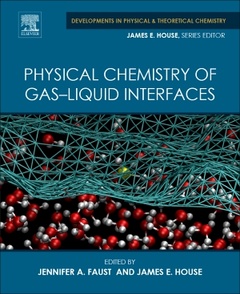Description
Physical Chemistry of Gas-Liquid Interfaces
Developments in Physical & Theoretical Chemistry Series
Coordinators: Faust Jennifer A., House James E.
Language: English
Subject for Physical Chemistry of Gas-Liquid Interfaces:
Keywords
Adsorption; Aerosol mass spectrometer; Aerosol optical tweezers; Air�liquid interface; Air�water interface; Atmospheric aerosol; Atmospheric aerosols; Atmospheric new particle formation; Benzene; Biomineralization; Cavity-enhanced Raman spectroscopy; Chemical imaging; Clouds; Condensation; Cyclohexane; Electrodynamic balance; Fluctuations; Fog; Free energy/potential of mean force; Gas�liquid interface; Gas�liquid interfacial properties; General dynamic equation; Glancing-angle Raman; Grazing incidence diffraction; Heterogeneous chemistry; Heterogeneous reactions; Hydrophilicity; Hydroxyl radicals; Inelastic scattering; Infrared reflection�absorption spectroscopy; Instantaneous interface; Interfacial photochemistry; Interfacial structures; Ion distribution; Ion/solute distribution; Ionic liquid interface; Ionic liquid; Ionization; Laser ablation mass spectrometry; Lipid membranes; Liquid surfaces/interfaces; Liquid�vapor interface; Mass spectrometry; Mass transport; Microfluidics; Micro-Raman spectroscopy; Mixing state; Molecular beam scattering; Molecular collisions; Molecular dynamics simulations; Molecular identification; Molecular modeling and simulation; Monolayer; Multiphase photochemistry; Nanoparticles; Nucleation; Organic liquid interface; Oxidation; Ozone; Palmitic acid; Particle counter; Phase transition; Photoenhancement; Photoinduced radical formation; Photosensitization; Quantum chemistry; Reactive scattering; Reactive uptake; Scanning transmission X-ray microscopy; Scanning/transmission electron microscopy; Sea surface microlayer; Self-assembled monolayers; Single-particle analysis; Surface layering; Surface potential; Surface tension; Surface waves; Surfactants; Synchrotron X-rays; Thermodynamics of interfaces; Thermodynamics; Vibrational spectroscopy; Vibrational sum�frequency generation; Volatile organic compound; Volatile organic interfaces; Water�vapor interface; X-ray absorption microscopy; X-ray reflectivity
490 p. · 19x23.3 cm · Paperback
Description
/li>Contents
/li>Readership
/li>Biography
/li>Comment
/li>
Physical Chemistry of Gas-Liquid Interfaces, the first volume in the Developments in Physical & Theoretical Chemistry series, addresses the physical chemistry of gas transport and reactions across liquid surfaces. Gas?liquid interfaces are all around us, especially within atmospheric systems such as sea spry aerosols, cloud droplets, and the surface of the ocean. Because the reaction environment at liquid surfaces is completely unlike bulk gas or bulk liquid, chemists must readjust their conceptual framework when entering this field. This book provides the necessary background in thermodynamics and computational and experimental techniques for scientists to obtain a thorough understanding of the physical chemistry of liquid surfaces in complex, real-world environments.
1. Introduction to Gas–Liquid Interfaces 2. Experimental Studies of Gas–Liquid Interfaces 3. Theoretical Studies of Gas–Liquid Interfaces 4. Gas–Liquid Interfaces in the Atmosphere 5. Vibrational Spectroscopy 6. X-Ray Photoelectron Spectroscopy 7. X-Ray Scattering 8. Atomic, Molecular, and Ionic Scattering 9. Microfluidics at the Gas–Liquid Interface 10. Interfacial Fluctuations 11. Simulations of Surfactants 12. Organic Liquid Surfaces 13. New Particle Formation and Growth 14. Heterogeneous Aerosol Chemistry 15. Single Particles 16. Air–Sea Exchange 17. Interfacial Photochemistry
Graduate students and research scientists in academia and industry in physical chemistry and atmospheric science
J.E. House is Scholar in Residence, Illinois Wesleyan University, and Emeritus Professor of Chemistry, Illinois State University. He received BS and MA degrees from Southern Illinois University and the PhD from the University of Illinois, Urbana. In his 32 years at Illinois State, he taught a variety of courses in inorganic and physical chemistry. He has authored almost 150 publications in chemistry journals, many dealing with reactions in solid materials, as well as books on chemical kinetics, quantum mechanics, and inorganic chemistry. He was elected Professor of the Year in 2011 by the student body at Illinois Wesleyan University. He has also been elected to the Southern Illinois University Chemistry Alumni Hall of Fame. He is the Series Editor for Elsevier's Developments in Physical & Theoretical Chemistry series, and a member of the editorial board of The Chemical Educator.
- 2019 PROSE Awards - Winner: Category: Chemistry and Physics: Association of American Publishers
- Provides an interdisciplinary view of the chemical dynamics of liquid surfaces, making the content of specific use to physical chemists and atmospheric scientists
- Features 100 figures and illustrations to underscore key concepts and aid in retention for young scientists in industry and graduate students in the classroom
- Helps scientists who are transitioning to this field by offering the appropriate thermodynamic background and surveying the current state of research




